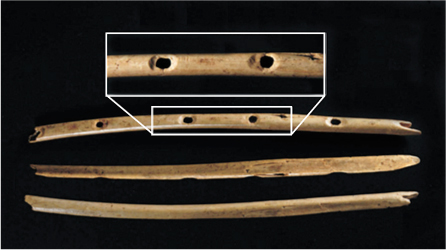Stone Age flutes found in Germany

A new report concludes that people living in Europe more than 35,000 years ago made this flute, shown from three different angles, out of a vulture bone. A magnified portion of the flute, top, provides a closer look at two of the flute's finger holes.
The hills may be alive with the sound of music, but so were vulture bones and mammoth tusks for ancient Europeans. Researchers working at two Stone Age German sites have unearthed a nearly complete flute made from a vulture’s forearm as well as sections of three mammoth-ivory flutes.
These 35,000- to 40,000-year-old finds are the oldest known musical instruments in the world, says archaeologist and project director Nicholas Conard of the University of Tübingen in Germany.
Bone flutes previously unearthed at Stone Age sites occupied by humans in France and Austria date to between 19,000 and 30,000 years ago. And many researchers now consider the spaced holes in a controversial 43,000-year-old find, dubbed a Neandertal bone flute in 1995, as the products of chewing by cave bears.
The bone flute, which excavators found in 12 pieces, and the ivory flutes were discovered in the summer of 2008 at Hohle Fels cave. The team reports in an upcoming Nature that the finds are from the time of the Aurignacian culture, when modern humans first migrated to Europe from Africa. Scientists estimate that the culture existed from about 40,000 to 29,000 years ago.
Conard’s group found no human bones near the ancient flutes. But since human remains accompany later Aurignacian finds at other sites, the scientists assume that Homo sapiens, not Neandertals, made the musical instruments.